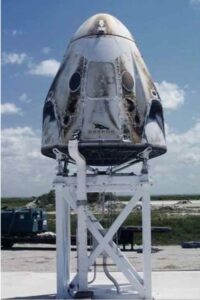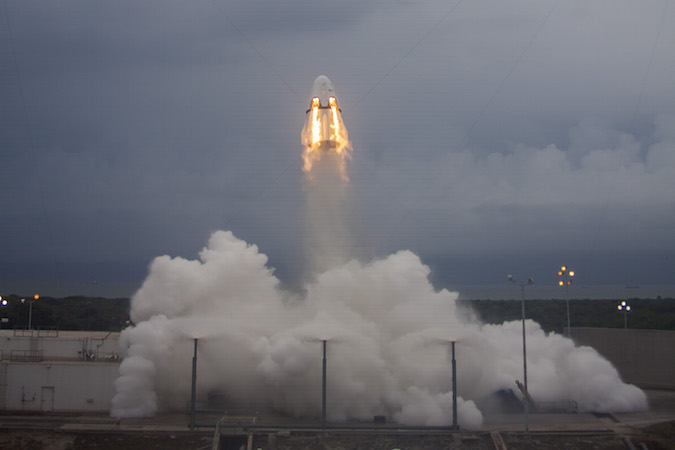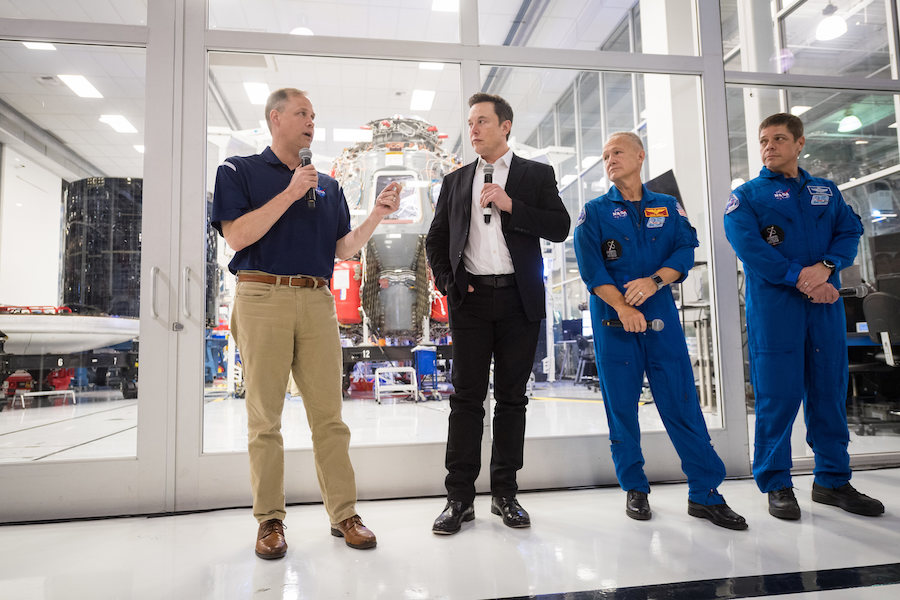Investigation into Crew Dragon incident continuesby Jeff Foust — May 28, 2019 [SN]
 The Demo-1 Crew Dragon spacecraft on a test stand shortly before the April 20 anomaly that destroyed it. Credit: NASAWASHINGTON — More than a month after a Crew Dragon spacecraft was destroyed in a test of its propulsion system, NASA and SpaceX investigators are still working to determine the cause of the accident and its implications for upcoming test flights.
The Demo-1 Crew Dragon spacecraft on a test stand shortly before the April 20 anomaly that destroyed it. Credit: NASAWASHINGTON — More than a month after a Crew Dragon spacecraft was destroyed in a test of its propulsion system, NASA and SpaceX investigators are still working to determine the cause of the accident and its implications for upcoming test flights.
In a May 28 presentation to the NASA Advisory Council’s human exploration and operations committee, Kathy Lueders, manager of the commercial crew program at NASA, offered few updates on the progress of the investigation into the April 20 incident at a SpaceX pad at Cape Canaveral Air Force Station in Florida.
In that incident, SpaceX was testing both the Draco thrusters and larger SuperDraco abort thrusters in preparation for an in-flight abort test of the capsule that, at the time, was scheduled for the end of June. “An anomaly occurred during activation of the SuperDraco system,” she said, but offered no details on what caused that anomaly.
Lueders did praise SpaceX for how it dealt with the accident and the ongoing investigation. “I will tell you that the team did a great job,” she said of the response. “The team followed the mishap plan beautifully. All the notifications were made. The SpaceX folks did a tremendous job.”
She also indicated that NASA has been kept in the loop about the accident and investigation, including NASA personnel who were at the SpaceX control room at the time the accident took place. A NASA team, she added, is embedded within SpaceX to help with the investigation, such as collecting all the data from the incident. SpaceX, though, is leading the investigation.
The capsule destroyed in the test was the one that flew to the International Space Station on the Demo-1 test flight in March. SpaceX planned to use that capsule on the in-flight abort test this summer.
With that capsule destroyed, Lueders said that SpaceX will use the Crew Dragon spacecraft originally intended for the Demo-2 crewed flight test for the in-flight abort test. The Demo-2 mission will instead use the spacecraft SpaceX was building for the first operational mission, dubbed Crew-1.
With the investigation ongoing, Lueders said the dates of both the in-flight abort test and the Demo-2 mission are under review. Assembly of the Demo-2 capsule continues, she said, although she said workers are keeping open the vehicle’s propulsion system in case they need to make modifications as a result of the investigation. “They’re making progress in a lot of the other areas while trying to keep, most particularly in the prop area, access to the systems that may need to be modified,” she said.
She didn’t give an indication of when that investigation will be completed. “You don’t push your anomaly investigation team too quick,” she said, stressing the importance for them to be “methodical” while working through all parts of the fault tree of potential causes.
Later in the meeting, a committee member asked Lueders if Demo-2 could still fly this year. “They’re getting their vehicle ready by the end of year,” she said of SpaceX. “We need to close out the anomaly investigation. That’s the big thing.”
The accident, she said, was something of a “gift” to the program, since it took place on a test stand, giving them an opportunity to understand what may need to be modified. “We’re learning a lot. Sometimes you learn more from a failure like this,” she said.
“It’s pretty sad not to have that vehicle,” she added. “I was hoping that vehicle would be in a museum one day. But, I think this is a vehicle that continues to serve her purpose to make human spaceflight safer and safer. We will learn from this test, and that learning will be applied to the next vehicle.”Source:
https://spacenews.com/investigation-into-crew-dragon-incident-continues/NASA says SpaceX readying Crew Dragon capsule for possible piloted test flight by end of yearMay 28, 2019 William Harwood STORY WRITTEN FOR CBS NEWS & USED WITH PERMISSION [SFN]
 File photo of Kathy Lueders, NASA’s Commercial Crew Program manager. Credit: NASA/Robert Markowitz
File photo of Kathy Lueders, NASA’s Commercial Crew Program manager. Credit: NASA/Robert MarkowitzIn parallel with an on-going failure investigation, SpaceX is readying downstream Crew Dragon spacecraft for flight in hopes that corrective actions can be implemented in time to launch two astronauts to the International Space Station before the end of the year, a senior NASA manager said Tuesday.
SpaceX successfully launched an unpiloted Crew Dragon to the station in March on a mission known as Demo 1 and was gearing up to launch that same vehicle on another unpiloted mission in June to test its emergency abort system. That test was intended to clear the way for an initial test flight — Demo 2 — with astronauts on board later this summer.
https://spaceflightnow.com/2019/05/28/nasa-says-spacex-readying-crew-dragon-capsule-for-possible-piloted-test-flight-by-end-of-year/SpaceX points to leaky valve as culprit in Crew Dragon test accidentJuly 15, 2019 Stephen Clark [SFN]
 A prototype of SpaceX’s Crew Dragon capsule completed a pad abort test at Cape Canaveral in May 2015. Credit: SpaceX
A prototype of SpaceX’s Crew Dragon capsule completed a pad abort test at Cape Canaveral in May 2015. Credit: SpaceXInvestigators believe a leak of propellant inside the Crew Dragon spacecraft’s propulsion system led to the capsule’s explosion April 20 during a ground test at Cape Canaveral, and a senior SpaceX official said Monday that delays are making it “increasingly difficult” to fly astronauts on the commercial spaceship before the end of the year.
Engineers are replacing valves inside the Crew Dragon’s launch abort propulsion system to prevent similar leaks from happening in the future, according to Hans Koenigsmann, SpaceX’s Vice President of build and flight reliability.
https://spaceflightnow.com/2019/07/15/spacex-points-to-leaky-valve-as-culprit-in-crew-dragon-test-accident/Boeing, SpaceX aim for more commercial crew test flights this fallAugust 26, 2019 Stephen Clark [SFN]
 Technicians at Boeing’s satellite production facility in El Segundo, California, position a CST-100 Starliner inside an environmental test chamber for testing earlier this year. This specific Starliner vehicle will fly on Boeing’s Crew Flight Test, the first Starliner mission with astronauts on-board. Credit: Boeing
Technicians at Boeing’s satellite production facility in El Segundo, California, position a CST-100 Starliner inside an environmental test chamber for testing earlier this year. This specific Starliner vehicle will fly on Boeing’s Crew Flight Test, the first Starliner mission with astronauts on-board. Credit: BoeingBoeing’s Starliner crew capsule could take off in October on its first unpiloted test flight to the International Space Station, a company official said recently, while SpaceX finishes up the investigation into the explosion of its Crew Dragon spacecraft during a ground test earlier this year.
https://spaceflightnow.com/2019/08/26/boeing-spacex-aim-for-more-commercial-crew-test-flights-this-fall/SpaceX’s first rocket built for humans test-fired in TexasSeptember 5, 2019 Stephen Clark [SFN]
 The first stage of a SpaceX Falcon 9 rocket was test-fired Aug. 29 at the company’s test site in McGregor, Texas. The booster will launch NASA astronauts Bob Behnken and Doug Hurley on the Crew Dragon spacecraft. Credit: SpaceX
The first stage of a SpaceX Falcon 9 rocket was test-fired Aug. 29 at the company’s test site in McGregor, Texas. The booster will launch NASA astronauts Bob Behnken and Doug Hurley on the Crew Dragon spacecraft. Credit: SpaceXThe Falcon 9 booster assigned to launch two NASA astronauts on an orbital test flight of SpaceX’s Crew Dragon capsule has been test-fired in Texas, but the schedule for the long-awaited mission remains unclear.
https://spaceflightnow.com/2019/09/05/spacexs-first-rocket-built-for-humans-test-fired-in-texas/NASA may ask SpaceX to extend duration of Crew Dragon test flightOctober 7, 2019 Stephen Clark [SFN]
 NASA astronaut Bob Behnken is pictured during a formal verification of SpaceX’s emergency escape system Sept. 18 at launch pad 39A at NASA’s Kennedy Space Center in Florida. Behnken is wearing a SpaceX spacesuit in this image. Credit: SpaceX
NASA astronaut Bob Behnken is pictured during a formal verification of SpaceX’s emergency escape system Sept. 18 at launch pad 39A at NASA’s Kennedy Space Center in Florida. Behnken is wearing a SpaceX spacesuit in this image. Credit: SpaceXNASA astronauts Bob Behnken and Doug Hurley may spend more time on the International Space Station than originally planned when they ride SpaceX’s new human-rated Dragon spacecraft into orbit on its first crewed test flight, a space agency official said Friday.
https://spaceflightnow.com/2019/10/07/nasa-may-ask-spacex-to-extend-duration-of-crew-dragon-test-flight/NASA chief says SpaceX properly focused on Crew DragonOctober 10, 2019 William Harwood [SFN]
 NASA Administrator Jim Bridenstine, center, speaks to SpaceX CEO Elon Musk, right, while viewing an “OctaWeb” for one of SpaceX’s Falcon 9 rockets. Credit: NASA/Aubrey Gemignani
NASA Administrator Jim Bridenstine, center, speaks to SpaceX CEO Elon Musk, right, while viewing an “OctaWeb” for one of SpaceX’s Falcon 9 rockets. Credit: NASA/Aubrey GemignaniNASA Administrator Jim Bridenstine visited SpaceX’s California rocket factory Thursday, toured the sprawling facility with founder Elon Musk and told reporters he is optimistic the company will be ready to launch the first piloted test flight of its Crew Dragon spaceship in the first quarter of next year.
https://spaceflightnow.com/2019/10/10/nasa-chief-says-spacex-properly-focused-on-crew-dragon/Bridenstine says NASA not holding up commercial crew scheduleOctober 25, 2019 Stephen Clark [SFN]
 NASA Administrator Jim Bridenstine (left) visited SpaceX headquarters in Hawthorne, California, on Oct. 10. SpaceX founder and CEO Elon Musk and NASA astronauts Doug Hurley and Bob Behnken (left to right) joined Bridenstine for a media availability in Hawthorne. Credit: NASA/Aubrey Gemignani
NASA Administrator Jim Bridenstine (left) visited SpaceX headquarters in Hawthorne, California, on Oct. 10. SpaceX founder and CEO Elon Musk and NASA astronauts Doug Hurley and Bob Behnken (left to right) joined Bridenstine for a media availability in Hawthorne. Credit: NASA/Aubrey GemignaniNASA Administrator Jim Bridenstine said this week the space agency is not unduly delaying the debut of new SpaceX and Boeing commercial crew capsules as engineers gear up for a challenging rapid-fire sequence of test flights in the next few months, all against the backdrop of in-depth safety reviews before clearing the privately-owned ships to carry astronauts.
https://spaceflightnow.com/2019/10/25/bridenstine-ccp-safety-reviews/